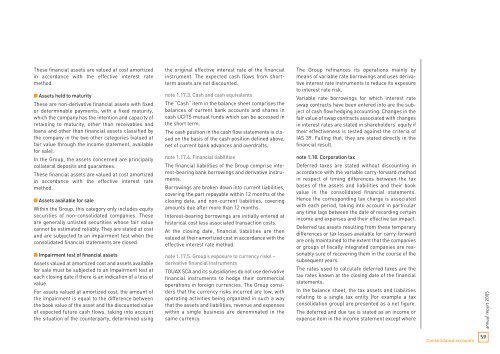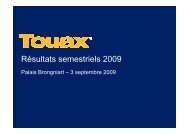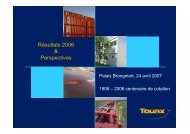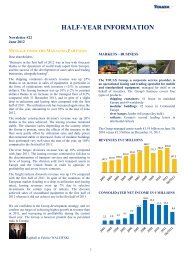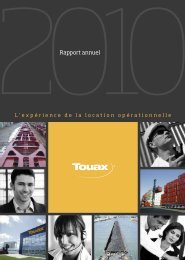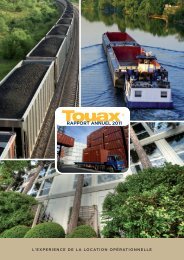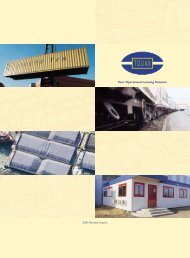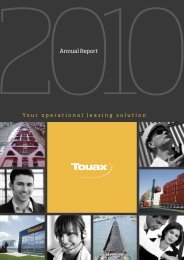2005 Annual Report - Touax
2005 Annual Report - Touax
2005 Annual Report - Touax
Create successful ePaper yourself
Turn your PDF publications into a flip-book with our unique Google optimized e-Paper software.
These financial assets are valued at cost amortized<br />
in accordance with the effective interest rate<br />
method.<br />
■ Assets held to maturity<br />
These are non-derivative financial assets with fixed<br />
or determinable payments, with a fixed maturity,<br />
which the company has the intention and capacity of<br />
retaining to maturity, other than receivables and<br />
loans and other than financial assets classified by<br />
the company in the two other categories (valued at<br />
fair value through the income statement, available<br />
for sale).<br />
In the Group, the assets concerned are principally<br />
collateral deposits and guarantees.<br />
These financial assets are valued at cost amortized<br />
in accordance with the effective interest rate<br />
method.<br />
■ Assets available for sale<br />
Within the Group, this category only includes equity<br />
securities of non-consolidated companies. These<br />
are generally unlisted securities whose fair value<br />
cannot be estimated reliably. They are stated at cost<br />
and are subjected to an impairment test when the<br />
consolidated financial statements are closed.<br />
■ Impairment test of financial assets<br />
Assets valued at amortized cost and assets available<br />
for sale must be subjected to an impairment test at<br />
each closing date if there is an indication of a loss of<br />
value.<br />
For assets valued at amortized cost, the amount of<br />
the impairment is equal to the difference between<br />
the book value of the asset and the discounted value<br />
of expected future cash flows, taking into account<br />
the situation of the counterparty, determined using<br />
the original effective interest rate of the financial<br />
instrument. The expected cash flows from shortterm<br />
assets are not discounted.<br />
note 1.17.3. Cash and cash equivalents<br />
The “Cash” item in the balance sheet comprises the<br />
balances of current bank accounts and shares in<br />
cash UCITS mutual funds which can be accessed in<br />
the short term.<br />
The cash position in the cash flow statements is closed<br />
on the basis of the cash position defined above,<br />
net of current bank advances and overdrafts.<br />
note 1.17.4. Financial liabilities<br />
The financial liabilities of the Group comprise interest-bearing<br />
bank borrowings and derivative instruments.<br />
Borrowings are broken down into current liabilities,<br />
covering the part repayable within 12 months of the<br />
closing date, and non-current liabilities, covering<br />
amounts due after more than 12 months.<br />
Interest-bearing borrowings are initially entered at<br />
historical cost less associated transaction costs.<br />
At the closing date, financial liabilities are then<br />
valued at their amortized cost in accordance with the<br />
effective interest rate method.<br />
note 1.17.5. Group’s exposure to currency risks –<br />
derivative financial instruments<br />
TOUAX SCA and its subsidiaries do not use derivative<br />
financial instruments to hedge their commercial<br />
operations in foreign currencies. The Group considers<br />
that the currency risks incurred are low, with<br />
operating activities being organized in such a way<br />
that the assets and liabilities, revenue and expenses<br />
within a single business are denominated in the<br />
same currency.<br />
The Group refinances its operations mainly by<br />
means of variable rate borrowings and uses derivative<br />
interest rate instruments to reduce its exposure<br />
to interest rate risk.<br />
Variable rate borrowings for which interest rate<br />
swap contracts have been entered into are the subject<br />
of cash flow hedging accounting. Changes in the<br />
fair value of swap contracts associated with changes<br />
in interest rates are stated in shareholders’ equity if<br />
their effectiveness is tested against the criteria of<br />
IAS 39. Failing that, they are stated directly in the<br />
financial result.<br />
note 1.18. Corporation tax<br />
Deferred taxes are stated without discounting in<br />
accordance with the variable carry-forward method<br />
in respect of timing differences between the tax<br />
bases of the assets and liabilities and their book<br />
value in the consolidated financial statements.<br />
Hence the corresponding tax charge is associated<br />
with each period, taking into account in particular<br />
any time lags between the date of recording certain<br />
income and expenses and their effective tax impact.<br />
Deferred tax assets resulting from these temporary<br />
differences or tax losses available for carry-forward<br />
are only maintained to the extent that the companies<br />
or groups of fiscally integrated companies are reasonably<br />
sure of recovering them in the course of the<br />
subsequent years.<br />
The rates used to calculate deferred taxes are the<br />
tax rates known at the closing date of the financial<br />
statements.<br />
In the balance sheet, the tax assets and liabilities<br />
relating to a single tax entity (for example a tax<br />
consolidation group) are presented as a net figure.<br />
The deferred and due tax is stated as an income or<br />
expense item in the income statement except where<br />
annual report <strong>2005</strong><br />
Consolidated accounts<br />
59


